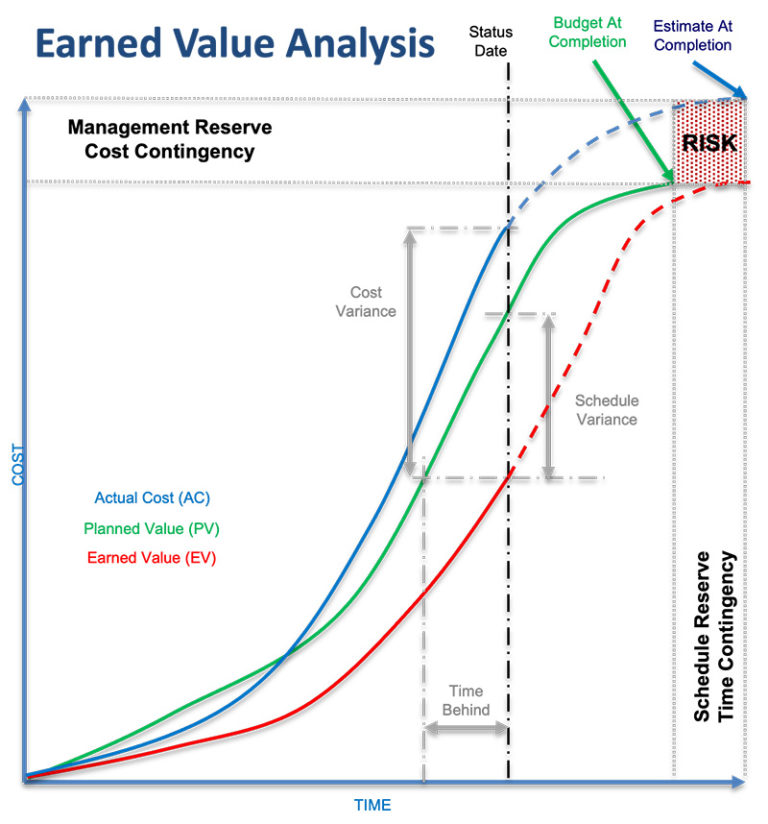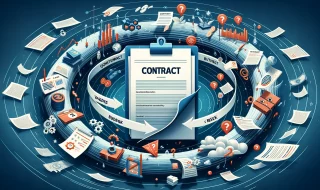EVM, or Earned Value Management, is a commonly used method in project management to measure the performance of the project in progress.
The EVM is relevant in project control and monitoring. This method enables a link to be made between the planning defined at the start of the project and the costs – two essential components in the smooth running of a project.
It provides a valuable analysis of the results to be expected. Its main objective is therefore to control and avoid cost overruns, one of the main problems of very complex projects. If necessary, EVM can help to prevent overspending by taking corrective action in good time.
The benefits of Earned Value Management in project management
Mapping of work and costs:
EVM enables actual costs to be tracked against the initial planning, providing a clear mapping of the work carried out and associated costs.
Reducing unknowns to quantifiable factors:
By converting project performance into financial values, EVM reduces uncertainties, providing a more accurate understanding of the state of the project.
Comparison of the current state with the project baseline:
The EVM enables actual performance to be compared with the project baseline, identifying discrepancies and aiding corrective action.
Identifying critical paths:
By assessing costs and performance, EVM helps to identify critical project paths, helping to focus efforts where they are most needed.
Creating a data-driven framework for future decision-making:
The EVM provides a solid database for making informed decisions about the project, whether to adjust the budget, the scope, or to allocate resources appropriately.
Rapid, early intervention:
EVM enables early detection of potential problems, allowing rapid intervention, whether by adjusting the scope, allocating more resources or modifying other project parameters.
Greater visibility and accountability for stakeholders:
The use of clear, quantifiable measures helps to make the project more visible, which in turn helps to empower stakeholders and maintain transparent communication.
Project and portfolio overview:
The EVM provides a complete overview of the project and can also be extended to provide information on the entire project portfolio, facilitating overall management.
EVM in practice: how to control a project using earned value management
In its methodology, the EVM takes into account three parameters: the timetable, the cost and the scope of the project. Based on these three criteria, and on planned and actual values, the EVM will be able to estimate trends.
For its analysis, EVM measures the earned value of a project (EV), i.e. the value of the work already carried out, and compares it with the planned value (PV), i.e. the value of the work corresponding to the planning defined, as well as the Actual Cost (AC). Here are the three values to remember:
Earned value = EV
Planned value = PV
Actual cost = AC
The planned value PV
The planned value corresponds to the reference value, which is the one that needs to be respected. It corresponds to Budgeted Cost of Work Scheduled.
The actual cost AC
The actual cost is the Actual Cost of Work Performed.
The earned value EV
The earned value therefore corresponds to Budgeted Cost for Work Performed.
Analysis of SV and CV variance
Once the three values have been obtained, we need to measure the variance in order to understand whether or not the project is on the right track. Here, there are two values to examine:
Schedule Variance SV: used to measure deviation from schedule.
To calculate Schedule Variance, the equation is as follows: SV = EV – PV
Value | Representation |
|---|---|
SV < 0 | A negative SV means that the project is behind schedule |
SV > 0 | A positive SV means that the project is ahead of schedule |
SV = 0 | A zero SV means that the project is right on schedule. |
Cost Variance CV: used to measure the deviation from cost.
To calculate Cost Variance, the equation is as follows: CV = EV – AC
Value | Representation |
|---|---|
CV > 0 | A positive CV implies that expenditure is higher than budgeted |
CV < 0 | A negative CV means that expenditure is lower than budgeted |
CV = 0 | A zero CV means that expenditure is exactly in line with the planned budget. |
Analysis using performance indices
Another way of analysing project performance is to use the Schedule Performance Index SPI and the Cost Performance Index CPI.
The Schedule Performance Index SPI.
The method used to calculate this is as follows: SPI = AC/PV
Value | Representation |
|---|---|
SPI > 0 | A positive SPI means that the project is behind schedule |
SPI < 0 | A negative SPI means that the project is ahead of schedule |
SPI = 0 | A zero SPI means that the project is right on schedule |
The Cost Performance Index CPI
The method used to calculate this is as follows: CPI = EV/AC
Value | Representation |
|---|---|
CPI < 0 | A negative CPI means that expenditure is higher than budgeted |
CPI > 0 | A positive CPI implies that expenditure is lower than budgeted |
CPI = 0 | A zero CPI means that expenditure is exactly as budgeted |
By correlating the two parameters of time and cost in these analyses, it is possible to obtain a detailed view of the project’s progress in the near future and, if necessary, take the necessary corrective measures.
The fundamental principles of EVM
To implement the EVM methodology within a project, it is necessary to respect a few fundamental principles:
The organisation and scope of the project
Identify and define the scope of the project using the Work Breakdown Structure (WBS), the Project Organisational Structure (OBS), and the Responsibility Assignment Matrix (RACI).
Planning and budgeting:
Establish a baseline by grouping activities, defining milestones, assigning deadlines and allocating the budget.
Cost accounting:
Track actual costs and record accrued expenses for accurate measurement.
Analysis and performance report:
Calculate EV, PV and CA, variances and indices, identifying any corrective measures required.
Revision and maintenance of data:
Revise the baseline when authorised changes are made, involving proactive change and risk management. It is important to remember that a project is never rigid, but can evolve over time.
Choosing PROPRISM to ensure controls of your projects
PROPRISM deploys its expertise in Project Controls to offer you solutions tailored to the management and control of your projects. We have a team of experts capable of improving the quality of your projects, promoting productivity and strategic alignment, as well as reducing costs and ensuring deadlines. PROPRISM operates in the pharmaceutical, marine, construction, engineering, transport and infrastructure, and chemical industries.
Our experts play a key role in the success of your projects. Their experience is employed to ensure that resources are properly allocated and that budget forecasts are adhered to. Using agile methods and project management tools that encourage adaptability and responsiveness to change, they encourage improvement and productivity in project management. PROPRISM also plays an essential role in providing advice and assistance, and supports your teams throughout the project life cycle with ongoing training. We also ensure coordination and motivation throughout the project to guarantee its success. Thanks to our solid expertise and essential teamwork, we can work with you to make your projects successful.




